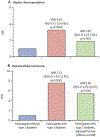Type 2 diabetes, hepatic decompensation, and hepatocellular carcinoma in patients with non-alcoholic fatty liver disease: an individual participant-level data meta-analysis
- PMID: 37419133
- PMCID: PMC10812844
- DOI: 10.1016/S2468-1253(23)00157-7
Type 2 diabetes, hepatic decompensation, and hepatocellular carcinoma in patients with non-alcoholic fatty liver disease: an individual participant-level data meta-analysis
Erratum in
-
Correction to Lancet Gastroenterol Hepatol 2023; published online July 4. https://doi.org/10.1016/S2468-1253(23)00157-7.Lancet Gastroenterol Hepatol. 2023 Sep;8(9):e7. doi: 10.1016/S2468-1253(23)00234-0. Epub 2023 Jul 18. Lancet Gastroenterol Hepatol. 2023. PMID: 37475118 No abstract available.
Abstract
Background: Data are scarce regarding the development of hepatic decompensation in patients with non-alcoholic fatty liver disease (NAFLD) with and without type 2 diabetes. We aimed to assess the risk of hepatic decompensation in people with NAFLD with and without type 2 diabetes.
Methods: We did a meta-analysis of individual participant-level data from six cohorts in the USA, Japan, and Turkey. Included participants had magnetic resonance elastography between Feb 27, 2007, and June 4, 2021. Eligible studies included those with liver fibrosis characterisation by magnetic resonance elastography, longitudinal assessment for hepatic decompensation and death, and included adult patients (aged ≥18 years) with NAFLD, for whom data were available regarding the presence of type 2 diabetes at baseline. The primary outcome was hepatic decompensation, defined as ascites, hepatic encephalopathy, or variceal bleeding. The secondary outcome was the development of hepatocellular carcinoma. We used competing risk regression using the Fine and Gray subdistribution hazard ratio (sHR) to compare the likelihood of hepatic decompensation in participants with and without type 2 diabetes. Death without hepatic decompensation was a competing event.
Findings: Data for 2016 participants (736 with type 2 diabetes; 1280 without type 2 diabetes) from six cohorts were included in this analysis. 1074 (53%) of 2016 participants were female with a mean age of 57·8 years (SD 14·2) years and BMI of 31·3 kg/m2 (SD 7·4). Among 1737 participants (602 with type 2 diabetes and 1135 without type 2 diabetes) with available longitudinal data, 105 participants developed hepatic decompensation over a median follow-up time of 2·8 years (IQR 1·4-5·5). Participants with type 2 diabetes had a significantly higher risk of hepatic decompensation at 1 year (3·37% [95% CI 2·10-5·11] vs 1·07% [0·57-1·86]), 3 years (7·49% [5·36-10·08] vs 2·92% [1·92-4·25]), and 5 years (13·85% [10·43-17·75] vs 3·95% [2·67-5·60]) than participants without type 2 diabetes (p<0·0001). After adjustment for multiple confounders (age, BMI, and race), type 2 diabetes (sHR 2·15 [95% CI 1·39-3·34]; p=0·0006) and glycated haemoglobin (1·31 [95% CI 1·10-1·55]; p=0·0019) were independent predictors of hepatic decompensation. The association between type 2 diabetes and hepatic decompensation remained consistent after adjustment for baseline liver stiffness determined by magnetic resonance elastography. Over a median follow-up of 2·9 years (IQR 1·4-5·7), 22 of 1802 participants analysed (18 of 639 with type 2 diabetes and four of 1163 without type 2 diabetes) developed incident hepatocellular carcinoma. The risk of incident hepatocellular carcinoma was higher in those with type 2 diabetes at 1 year (1·34% [95% CI 0·64-2·54] vs 0·09% [0·01-0·50], 3 years (2·44% [1·36-4·05] vs 0·21% [0·04-0·73]), and 5 years (3·68% [2·18-5·77] vs 0·44% [0·11-1·33]) than in those without type 2 diabetes (p<0·0001). Type 2 diabetes was an independent predictor of hepatocellular carcinoma development (sHR 5·34 [1·67-17·09]; p=0·0048).
Interpretation: Among people with NAFLD, the presence of type 2 diabetes is associated with a significantly higher risk of hepatic decompensation and hepatocellular carcinoma.
Funding: National Institute of Diabetes and Digestive and Kidney Diseases.
Copyright © 2023 The Author(s). Published by Elsevier Ltd. This is an Open Access article under the CC BY 4.0 license. Published by Elsevier Ltd.. All rights reserved.
Conflict of interest statement
Declaration of interests RL serves as a consultant to Aardvark Therapeutics, Altimmune, Anylam/Regeneron, Amgen, Arrowhead Pharmaceuticals, AstraZeneca, Bristol-Myer Squibb, CohBar, Eli Lilly, Galmed, Gilead, Glympse bio, Hightide, Inipharma, Intercept, Inventiva, Ionis, Janssen, Madrigal, Metacrine, NGM Biopharmaceuticals, Novartis, Novo Nordisk, Merck, Pfizer, Sagimet, Theratechnologies, 89bio, Terns Pharmaceuticals, and Viking Therapeutics; and received research grants (via his institution) from Arrowhead Pharmaceuticals, AstraZeneca, Boehringer-Ingelheim, Bristol-Myers Squibb, Eli Lilly, Galectin Therapeutics, Galmed Pharmaceuticals, Gilead, Intercept, Hanmi, Intercept, Inventiva, Ionis, Janssen, Madrigal Pharmaceuticals, Merck, NGM Biopharmaceuticals, Novo Nordisk, Merck, Pfizer, Sonic Incytes, and Terns Pharmaceuticals; is a cofounder of LipoNexus; and has stock options in 89bio and Sagimet Biosciences. DQH has served as a consultant for Gilead Sciences and Eisai. AMA received grants from Novo Nordisk, Pfizer, and Target Pharma; payments were made to her institution. MN received grants from Allergan, Akero, Bristol-Myer Squibb, Gilead, Galectin, Genfit, GlaxoSmithKline, Conatus, Corcept, Enanta, Madrigal, Novartis, Novo Nordisk, Shire, Takeda, Terns, Viking, and Zydus. MN serves as a consultant to Altimmune, Boehringer-Ingelheim, Cytodyn, 89bio, EchoSens, GlaxoSmithKline, Madrigal, Merck, Novo Nordisk, Prespecturm, Roche diagnostic and Siemens, Terns, and Takeda; received speaker fees from Novo Nordisk, EchoSens; served as an advisory board or data safety monitoring board for Altimmune, Boehringer-Ingelheim, Cytodyn, 89bio, EchoSens, GlaxoSmithKline, Madrigal, Merck, Novo Nordisk, Prespecturm, Roche diagnostic and Siemens Altimmune, Boehringer-Ingelheim, Cytodyn, 89bio, EchoSens, GlaxoSmithKline, Madrigal, Merck, Novo Nordisk, Prespecturm, Roche diagnostic and Siemens, Terns and Takeda; and owns stock/stock options in Rivus Pharma, CIMA, and ChronWell. All other authors declare no competing interests.
Figures


Comment in
-
NAFLD and liver-related events: does type 2 diabetes have a key role?Lancet Gastroenterol Hepatol. 2023 Sep;8(9):777-778. doi: 10.1016/S2468-1253(23)00187-5. Epub 2023 Jul 4. Lancet Gastroenterol Hepatol. 2023. PMID: 37419134 No abstract available.
References
-
- Paik JM, Golabi P, Younossi Y, Mishra A, Younossi ZM. Changes in the global burden of chronic liver diseases from 2012 to 2017: the growing impact of NAFLD. Hepatology 2020; 72: 1605–16. - PubMed
-
- Riazi K, Azhari H, Charette JH, et al. The prevalence and incidence of NAFLD worldwide: a systematic review and meta-analysis. Lancet Gastroenterol Hepatol 2022; 7: 851–61. - PubMed
-
- Chew NWS, Ng CH, Tan DJH, et al. The global burden of metabolic disease: Data from 2000 to 2019. Cell Metab 2023; 35: 414–428. - PubMed

